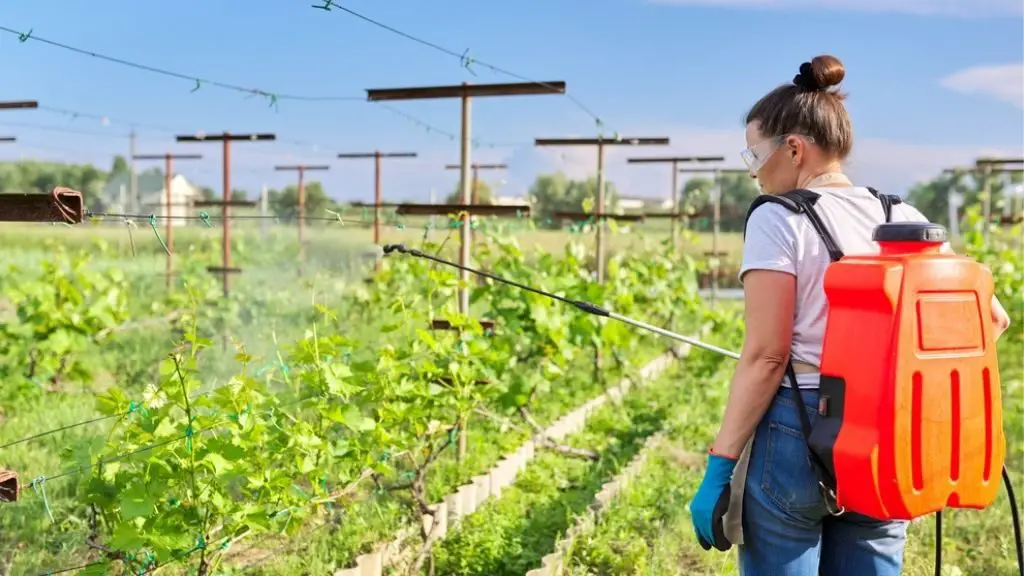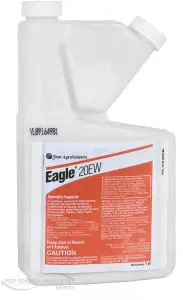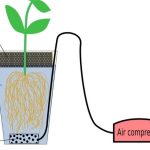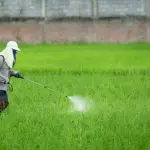How Long does Eagle 20 Stay in the Plant? Know Now!

Fungal diseases are a headache for the growers. Whether such diseases appear on plants or on turf, they can cause havoc. So, it becomes necessary to control and prevent these invasions to the Garden.
For this, different types of pesticides are used. Among them Eagle 20 is one of the best Anti-fungal pesticide treatments that can apply. It is super effective in dealing with fungal diseases on more than 100 plants, grass, trees, and vine species.
But it is also considered fairly toxic and it is absorbed by plants too. As long as it remains inside, plants are not safe to consume.
So, How long does eagle 20 stay in the plant?
The duration of Eagle 20 stays in the plant can vary depending on several factors like, the plant type, the rate of application, the method of application and the environmental conditions etc. Generally, this Anti-fungal pesticide may stay in the plants 1 weeks to 3 weeks (7 days to 21 days) according to the using schedule and rate of application to the plant. But this time period also may change and longing regarding the various factors influencing the plants.
Let’s dig deep to know in detail about this pesticide and its application to the plants.
How Does Eagle 20 Works?
Before jumping to the main point we must know how does this pesticide work. When the solution is applied to the plants, it is absorbed by the tissues. Then it moves upwards inside the plants. This migration allows them to cover each plant area. This is how the whole plant is protected. But what is the duration of this protection?
Plants are protected from 15 fungal diseases for 28 days after their application.
If you are applying it as a preventive control, then apply on the whole turf or field. Measure the square feet of the area for his too.
Author Tips: A pesticide license is required to purchase or use the Eagle 20.
How Long Does Eagle 20 Stay in the Plant?
How long does eagle 20 stay in the plant? Let us answer this most asked question!
Well if you talk about Myclobutanil residue, then it stays in plants for one week to three weeks.
The exact amount of time that Eagle 20 remains in a plant can also depend on the timing of the application in relation to the plant’s growth cycle, as well as the plant’s natural metabolism and ability to break down the chemical.
This product is absorbed by plants and migrates to different parts internally. If we talk about the solution as a whole, then in this situation, Eagle 20 stays in the plant for up to 12 weeks. But on which plants you can use it? Let’s have a look at that list!
On Which Plants You can Use Eagle 20?
Plants that Reap benefits from Eagle 20 are:
- Ornamental (chrysanthemums, daylilies, poinsettias, and roses)
- Turfgrass
- Nursery plants
- Apples
- Grapes
- Stone Fruits
- Other backyard fruits, trees, and vines.
It is labeled to use on more than 100 plants without causing any harm. Also, If you are a golf fan, then you must specially thank Eagle 20 manufacturers. It protects Golf turf from the dollar spots. Apply 0.5 to 2 fl. Oz. per 1000 square feet of the golf course. On residential turf, it prevents brown patches and springs dead spots too.
How to Apply Eagle 20 Fungicide?
Now, let’s address your How to apply Eagle 20 Fungicide query.
First, have a look at the tools you need: You will need the following things:
- Hand Pump, hose end, or backpack sprayer.
- Mask
- Gloves
- Goggles
Then do the following recommendations:
1) The first thing you need to do is determine the infected area measurements. Eagle 20 fungicide is recommended 0.5 to 2 fl. Oz. in a gallon of water for every 1000 square feet.
To calculate the square feet, measure the length and width of the infected area to get a better idea of how many doses should be given to the parents. Then according to recorded data, prepare the solution in the hand pump.
The rate of application of this pesticide differs from disease to disease and from low severity to high severity. Let us make you clear by telling an example.
To control Dollar spot fungal disease on the turf, it is recommended to add 1 fl. Oz in a gallon water per 1000 square feet. You measure the turf and get the final value of 40000 square feet. So, you will aff 4 fl. Oz. in four-gallon water for that 4000 square feet.
2) Add water to the pump in the next stage. Fill half the tank and then add Eagle 20EW dose. After that, fill the remaining tank with water and stir it.
3) Then, apply this pesticide and observe its effects. But How long does eagle 20 stay in the plant? The answer is 3 months and you may need to apply it more during this time frame.

Where to use it?
You can use it on:
- Turf
- Lawn
- Landscape Ornamentals
- Office Complexes
- Golf course
- Greenhouse
- Nursery
- Playing grounds
- Residential and commercial lawns
Ever wondered How Late Can I Use Eagle 20? Well, you can use this product within two years of its manufacturing date if it is stored in a cold environment. Also, if you use it within two years, then do it with care, otherwise, prepare for some effects.
What is Eagle 20 Actually?
Eagle 20 is a fungicide that is used to treat plants, vines, trees, and grasses affected by fungal diseases. It is mixed in the water and sprayed on the plants which effectively cures plants suffering from fungal diseases.
Moreover, you can also spray it before the occurrence of any disease as a preventive measure too. Pretty Exciting right? But application rate is different in both scenarios ( Disease control spray and Preventive spray) which we describes in the Article.
But let us tell you that use Eagle 20EW carefully in the recommended way only. Why? Because it contains the chemical Myclobutanil which is fairly toxic. Myclobutanil is present 19.7 percent in the Eagle 20EW product and is also the main ingredient.
What are the Benefits of using Eagle 20 Fungicide?
If you apply the Eagle 20, then you will enjoy the following benefits:
- It prevents and controls fungal diseases.
- It can be applied to a wide range of plants (more than 100 species).
- Eagle 20 in flower allows top-notch blooming.
- A liquid solution is easy to make and easy to apply.
- These systemic fungicides do Systemic protection.
Which Fungal diseases Eagle 20 cures?
Eagle 20 is known to control more than 15 fungal diseases that attack plants. Eagle 20 in flower leads to better fruit quality. So, it is obvious why people prefer it over others.
Fungal diseases Eagle 20 cures are:
- Anthracnose
- Dollar Spot
- Powdery Mildew
- Leaf Spot
- Rusts
- Septora leaf spot
- Zonate leaf spot
- Red thread
- Necrotic ring spot
- Zoysia large patch
- Spring dead spot
It is also used as a preventive measure for these diseases too. If it is applied just before the flowering stage to prevent any attack from the above-mentioned diseases. This preventive application has another benefit that when the time of harvesting will arrive, Eagle 20 will be out of the plants. Make sure you get your timing right as eagle 20 in flower can cause complications.
Out of all these diseases, Eagle 20 vs. Powdery Mildew Infection debate happens the most.
Eagle 20 vs. Powdery Mildew Infection
As powdery mildew is the most common disease among the above-mentioned diseases, so its treatment is discussed more. When the growing season is about to end, powdery mildew spores are formed in the fruiting bodies. It generally affects plants’ flowering.
But that does not mean powdery mildew does nothing during vegetative growth. It stunts the growth of plants too. Furthermore, when it gets severe, Powdery mildew infection can even cause the death of plants and grasses. So, How to handle powdery mildew? Luckily, Eagle 20 treats powdery mildew effectively.
Use a wetting agent like a Coco Wet while applying. Sync Fungcicide Activator is also recommended while spraying to boost the effectiveness. Experts recommend applying Eagle 20 with other management practices for better results.
If the problem is severe, then apply again after a few days. The best schedule of the application is 7 to 14 days. In some cases, it may take 8 weeks of application of this pesticide to get rid of diseases.
Eagle 20 Side Effects
Eagle 20 is not harmful to humans and pets if used in the recommended amount.
Still, as a precaution, wear a mask, gloves, and goggles before applying them for further protection. After the application, keep children and pets away for some time from the treated area until it completely dries. Furthermore, don’t mow or water the treated area after applying for at least 24 hours. If you do, then the product will lose its effectiveness.
If you do not follow precautions, then prepare to witness some Eagle 20 side effects. You may face respiratory diseases, neurological complications, and cardiovascular problems.
But, pesticides like Eagle 20 are now considered to be the death of Cannabis consumers. Yes, you read that right. Let’s see how!
Eagle 20 and Marijuana Plants
Eagle 20 spray is not desirable for Cannabis growers. Whether it is medical marijuana plants or other cannabis products, you must avoid pesticides like these.
Since Eagle 20 remains in the plant leave tissues too, so cannabis growers should not apply it to the marijuana plants. Why? Well, let us share some disturbing information with you.
People consume cannabis products by vaping them. If the cannabis product has myclobutanil residues (Eagle 20 ingredient), then it can cause death. How? Because when myclobutanil is burned, it becomes Hydrogen Cyanide which is very harmful to humans. Small exposure to Hydrogen Cyanide may not prove fatal, but prolonged exposure can cause respiratory, cardiovascular, and neurological diseases and can also cause deaths too.
To cure powdery mildew, you can use hydrogen peroxide as an eagle 20 alternative. You can also use neem oil and Procidic2 as well due to their fungicidal properties. Procidic2 is also gaining popularity and you can purchase this plant fungicide from hydrofarm, home depot, and the company’s original website.
Final Words
All in all, every grower’s priority is to protect plants from any kind of disease attack especially fungal. Fungal diseases not only cause the quality of plants to drop but also lead to their death too. So, in this situation, many recommend using Eagle 20 to cure and also to further prevent the spread of different fungal diseases.
It is mixed in water and sprayed directly on the plants. This solution is then absorbed by plants that remain in them for weeks. Many asked How long does eagle 20 stay in the plant, well the estimate is up to 12 weeks (3 months).
To avoid any harmful side effects on your, pets, or plants’ health, use the solution in the recommended. If you don’t, then prepare for something bad!
FAQs Related to How long does eagle 20 stay in the plant
How long does Eagle 20 last in a plant?
Eagle 20 lasts about three months in the plants. Its solution is absorbed by the tissues and migrates inside them. Due to this, plant parts are safe. But those time range varies as there are some examples of Eagle 20 fungicide to last for just 8 weeks in the plants. But, if anyone asks How long does eagle 20 stay in the plant, then stay on the safer side and answer up to 3 months.
Is Eagle 20 harmful to humans?
Eagle 20 does contain some toxicity but it does not affect humans if applied in the recommended way. If you don’t follow the instructions written on the label of this product, then you will definitely end up causing harm to yourself. Moreover, follow precautions while applying this product as well. Wear gloves, masks, and goggles to protect yourself.
How long does myclobutanil stay in a plant?
It stays between one week to three weeks inside the plants.
Does Eagle 20 go bad?
It only goes bad if not applied in the right way. Add the Eagle 20 in water in the recommended amount and this will cure plants. But if you don’t, then this pesticide solution will not do what you expect.
Related Topics:











